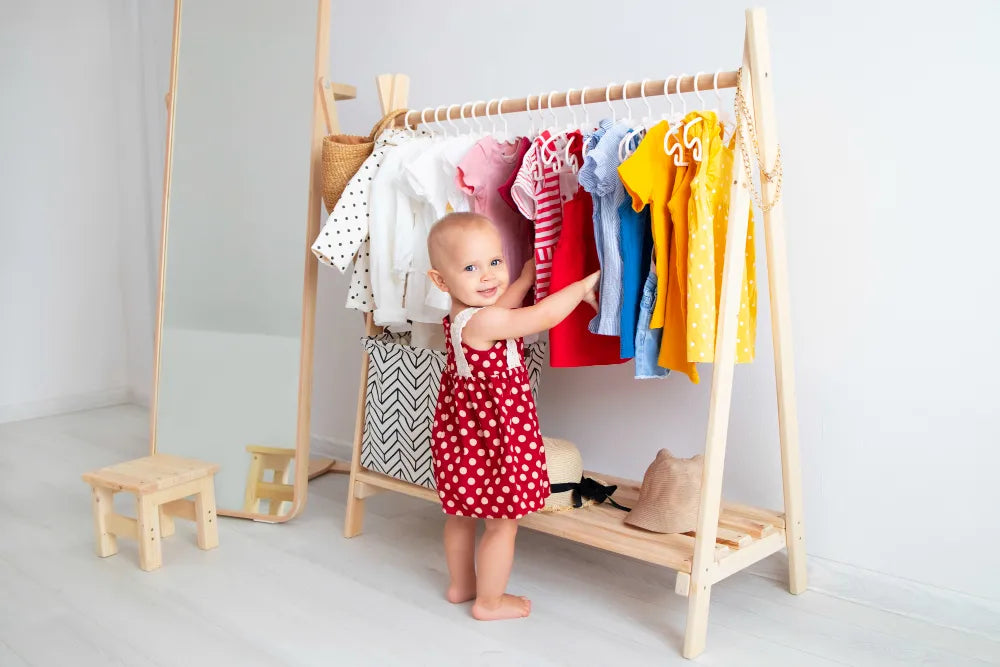Dressing your baby properly is one of the most important things you can do as a parent. Understanding how to dress your baby for both summer's warmth and winter's cold is essential for keeping them comfortable and healthy.
Babies are especially sensitive to temperature changes, which makes dressing them correctly essential for keeping them comfortable. Proper dressing helps them sleep well and ensures their overall happiness throughout the day.
This guide will take you through a comprehensive baby dressing guide, covering season-specific clothing tips and a temperature guide for dressing babies at night, as well as recommendations for daytime wear.
What to Know Before Dressing Your Baby

Babies are less effective at regulating their body temperature than adults, so it's important to monitor their comfort and adjust their clothing as needed.
Baby's Temperature Sensitivity: Babies can easily become too hot or too cold because their bodies can't regulate their own temperature effectively. Therefore, frequent checks are necessary to keep them comfortable.
Signs of Discomfort: Look for signs such as flushed skin, sweating, or cold hands and feet. If your baby is too hot, they may be fussy, while being too cold can make them restless. These are signals to adjust their clothing.
How to Assess Baby's Comfort: Feel your baby's neck or back to assess their temperature. If their skin feels hot, remove a layer; if it is cold, add one. This ensures your baby stays comfortable throughout the day.
The Importance of Layering: Layering allows for easy adjustments, which is crucial as babies are more sensitive to temperature changes. Use breathable fabrics like cotton for the base layer, and add warmth with wool or fleece. Avoid heavy, non-breathable fabrics to prevent overheating.
Adapting to Seasons: Layering is especially useful in transitional seasons like spring and fall, where temperatures fluctuate. It's also effective for adjusting between indoor and outdoor environments.
Essential Clothing Pieces for Layering
When layering your baby, it's important to have the right essential clothing pieces to build a comfortable outfit. These include:
- Onesies and Bodysuits: Perfect for the base layer. They provide warmth, comfort, and ease of movement for your baby.
- Tops and Bottoms: Light cardigans, sweaters, and pants that can be easily added or removed based on the weather.
- Outerwear: A jacket or sleep sack that provides extra warmth, especially when taking your baby outside or during cooler evenings.
Baby Dressing Guide: Dressing for Each Season

Now that you know the basics of baby comfort, let's dive into how to dress your baby for each season. Here are some specific tips for different weather conditions:
Spring: Light Layers and Versatility
Spring weather can be mild, but mornings and evenings are often chilly. During the day, temperatures can be quite comfortable, but they can drop quickly at night.
What to Wear: For daytime, light cotton onesies or rompers are perfect. Pair these with a thin cardigan or sweater for cooler mornings and evenings.
Baby Sleep Dressing Guideline: Opt for a soft sleep sack or a light swaddle to keep your baby cozy overnight without causing it to overheat.
Summer: Breathable Fabrics and Light Clothing
It's essential to keep your baby cool and comfortable during warm days.
What to Wear: Choose breathable fabrics like cotton or linen for onesies, rompers, and dresses. Avoid overdressing your baby, as they are more prone to overheating during the hot months.
Baby Sleep Dressing Guideline: For sleep, use a lightweight sleep sack or a short-sleeved onesie. Avoid heavy sheets to reduce the risk of overheating.
Fall: Layering with Cozy Fabrics
As temperatures drop, it's time to bring out the warmer layers. Fall brings crisp air in the mornings and evenings, so dressing your baby in cozy fabrics will keep them comfortable.
What to Wear: Soft, cozy fabrics like wool or fleece work well in the fall. Layer these over cotton onesies to keep your baby warm without making them too hot.
Baby Sleep Dressing Guideline: Add an extra layer, such as a long-sleeve sleep suit or wearable blanket, to keep your baby cozy on cooler nights.
Winter: Warmth and Protection from the Cold
Winter calls for extra insulation to keep your baby warm and cozy.
What to Wear: Dress your baby in fleece-lined onesies, hats, mittens, and socks. Layering is important to keep your baby warm while ensuring they don't overheat.
Baby Sleep Dressing Guideline: Use a full-body sleeper or an insulated sleep sack for sleep. This will keep your baby warm without the need for extra blankets, which could be a suffocation hazard.
Temperature Chart for Dressing Your Baby Based on Room Temperature
|
Room Temperature (°F) |
Recommended Clothing |
|
68°F – 72°F |
Onesie, sleeper, sleep sack |
|
60°F – 68°F |
Onesie, long-sleeve shirt, sleep sack or blanket |
|
50°F – 60°F |
Warm sleeper, socks, mittens |
|
Below 50°F |
Fleece-lined sleeper, hat, mittens, socks |
Tips for Dressing Your Baby in Different Temperatures
It is tempting to dress your baby in trendy clothes for every season and occasion, but here are some points you need to consider.
Monitor Room Temperature: Keep your baby's room between 68°F and 72°F for a comfortable sleep. Use a room thermometer to ensure the temperature is comfortable for your baby.
Check for Signs of Overheating or Cold: If your baby is sweating, looks flushed, or is uncomfortable, it may be too hot or too cold. If their skin feels cold, especially their hands and feet, they may need an extra layer.
Dress According to Activity: If your baby is active and playing, they may need fewer layers than when they are sleeping. Always adjust their clothing based on their activity level to ensure they are comfortable.
Avoid Overlayering: Stick to the appropriate number of layers for each season, and always check your baby's temperature regularly.
Don't Use Blankets in the Crib: Instead of blankets, use sleep sacks and wearable blankets to keep your baby warm without the risk of suffocation.
Be Mindful of Tight Clothing: Avoid tight clothing that restricts your baby's movement. Choose stretchy fabrics or adjustable designs for better comfort.
Conclusion
Dressing your baby for each season may seem daunting, but by following a baby dressing guide and understanding your baby's comfort, you can ensure that they are dressed appropriately for the weather. From light layers in spring to cozy, warm fabrics in winter, choosing the right clothes will help keep your baby comfortable all year round.
Find the Best Baby Clothing for All Seasons at Magickal Wear
At Magickal Wear, parents can find stylish and comfortable baby outfits for every season. Whether you're looking for breathable fabrics for summer or cozy winter wear, we offer a wide selection that combines comfort, style, and practicality.
Visit Magickal Wear for a range of seasonal clothing that keeps your baby comfortable and fashionable year-round.
FAQs
How do I know if my baby is too hot or too cold?
Check your baby's neck or back for signs of warmth or coolness. If they're sweating or feel too warm, remove a layer. If their skin is cold, add an extra layer.
Can I use a regular blanket for my baby at night?
It's safer to use wearable blankets or sleep sacks instead of regular blankets, as they can reduce the risk of suffocation.
How should I dress my baby for outdoor activities in winter?
In winter, dress your baby in warm layers, including a hat, mittens, and socks. Choose insulated, weatherproof clothing for outdoor activities and always cover their ears and head.


